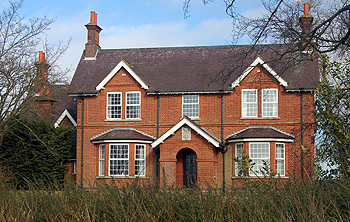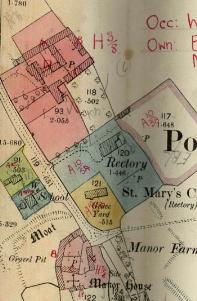Manor Farm Potsgrove

Manor Farmhouse February 2012
The Bedfordshire Historic Environment Record [HER] contains information on the county’s historic buildings and landscapes and summaries of each entry can now be found online as part of the Heritage Gateway website. The entry for Manor Farm [HER 16371] states: “Manor Farm in Potsgrove is a 19th century model farm complex which has been largely demolished and new buildings are present on the site”.
During the First World War Britain’s merchant shipping was subjected to a prolonged campaign of unrestricted warfare by German U-Boats. Just as in the Second World War it was feared that the country might be starved into submission. In 1915 county councils were ordered to set up War Agricultural Executive Committees which had the task of maximising food production and by 1917 things were so grim that they set about finding pasture and meadow which could be ploughed up and sown with arable crops.
Not surprisingly this was very unpopular with farmers who disliked being told how to farm by “bureaucrats” and who maintained, with some justification, that meadow and pasture was kept that way for a reason – it was needed to support animals and was of marginal use for arable crops. Many farmers appealed against decisions to force them to plough up certain fields and, when crops failed, put in claims for compensation. One such farmer was Robert Hedges of Manor Farm [WW1/AC/OP1/2], who was ordered to plough up 21.647 acres [WW1/AC/OP2/64]. In addition a horse temporarily kept at the farm to assist the ploughing damaged one of the stables. Fortunately the scheme to plough up grassland proved unnecessary when the Admiralty adopted the convoy system which reduced losses of merchant shipping to acceptable levels.
The Rating and Valuation Act 1925 specified that every building and piece of land in the country was to be assessed to determine its rateable value. The valuer visiting Manor Harm [DV1/H3/8] found that, like most of Potsgrove, it was owned by the Duke of Bedford. The tenant, John Albert Wright, had paid rent of £544/5/- since 1924, the pre-war rent having been £444/15/-. The valuer stated: "Saw Mr.Wright. Said Farm very good. Nearest market Leighton 6 miles. Nearest Station 5 miles (Woburn Sands). Damage to corn by game. Well water". Another hand wrote: "A large Farm the Arable land is very heavy. Much of the Grass is over timbered".
The farmhouse, built in 1903, comprised four reception rooms, a kitchen, a larder and a dairy with six bedrooms above and two attics above that. The farm buildings, annotated on the map below, comprised the following:
- North Block A: a brick and tile garage; a stable for five; a henhouse; four brick and tile pigsties; a wood and slate loose box used as a workshop and a brick and slate cow house for eighteen.
- East Block B: a wood and tile seven-bay open shed and two wood and tile loose boxes
- South Block C: a brick and tile cow house for eleven; a brick and tile four-bay open shed and a brick and tile cow house for four.
- Centre Block D: a timber and tile cowhouse for twenty; a brick and tile workshop; a brick and tile seven-bay open shed; a small wood and tile barn and a wood and tile wood shed.
Across the road were:
- Block A: a wood and slate implement shed and a henhouse.
- Block B: a wood and slate six-bay cart shed; a wood and slate eight-bay hovel; a wood and slate stable for thirteen and a small timber and slate hay barn
- Block C: a five-bay open hovel.

Manor Farm as annotated on the 1925 rating valuation map
to see a larger version please click on the image
Directories for Bedfordshire were not published every year but every few years from the early to mid 19th century until 1940. Farmers are listed below:
- 1890 John William Graves;
- 1906, 1910, 1914 and 1920: Robert Hedges;
- 1924, 1928 and 1931: John Albert Wright;
- 1936 and 1940 Herbert Harry Wright.